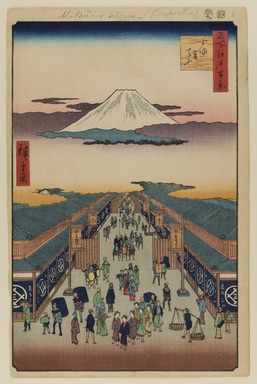
Artist:Utagawa Hiroshige
Medium: Woodblock print
Geograhical Locations:
Dates:9th month of 1856
Dimensions: Image: 13 1/2 x 8 5/8 in. (34.3 x 21.9 cm) Sheet: 14 3/16 x 9 1/8 in. (36 x 23.2 cm)
Collections:
Exhibitions:
Accession Number: 30.1478.8
Image: 30.1478.8_PS20.jpg,
Catalogue Description: Mid-day scene looking part Edo's premier store, the Echigoya, (today Mitsukoshi Department Store and still the most venerable and most fashionable of all the great merchandisers of Tokyo). The name "Suruga-cho" was taken from the view itself, after the province (today Shizuoka Prefecture) in whose territory the summit of Mount Fuji lay. The circle design repeated along the store is the Mitsui (family name) trademark. Echigoya (the name designating the Mitsui family origins in the province which is now Niigata Prefecture) occupied both corners of Suruga-cho, as seen here from the main Nihonbashi thoroughfare. The store on the left (today the department store, renamed Mitsukoshi in 1904 by taking one character each from "Mitsui" and "Echigoya") dealt in silk fabrics, while the one on the right (today the Mitsui Bank) dealt in nonsilk fabrics. Among the diverse figures in the street are men shouldering large blue packs filled with dry goods ready for delivery. Note the "Genji" clouds (named after their use in illustrated versions of the "Tale of Genji"), one of several cloud forms used in traditional Japanese painting, originally to separate scenes in pictorial narration.